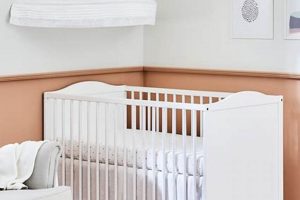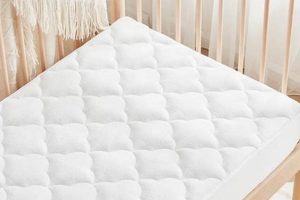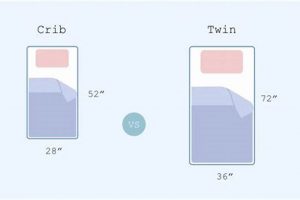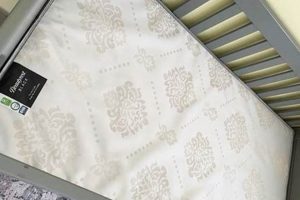The established dimensions for infant sleeping surfaces within the United States are governed by safety standards. These specifications ensure a snug fit within the crib frame, minimizing the risk of entrapment. For rectangular options, this typically translates to a width of approximately 27 1/4 inches and a length of 51 5/8 inches. Thickness can vary, but should not exceed 6 inches. These figures serve as a benchmark for manufacturers and consumers alike.
Adherence to these specifications is paramount for infant safety. Proper fitting eliminates gaps that could pose a suffocation hazard. Historically, the establishment of these dimensions arose from growing awareness of infant safety concerns and the need for standardized products. Selecting bedding that conforms to these standards provides parents with a degree of assurance regarding the safety of their child’s sleep environment.
Understanding these measurements is the foundational step in selecting the appropriate bedding. The following sections will delve into the specific regulations governing manufacture, testing methodologies employed to ensure compliance, and the potential consequences of deviating from these established dimensions.
Important Considerations
The following outlines crucial aspects for ensuring a safe sleep environment regarding infant bedding.
Tip 1: Verify Compliance: Prior to purchase, confirm the selected bedding adheres to established dimensional regulations. Check product labeling for confirmation of compliance with ASTM standards or other relevant regulatory bodies.
Tip 2: Measure Interior Dimensions: Before acquiring bedding, accurately measure the interior of the crib frame. These measurements should align closely with the bedding’s stated dimensions, allowing for a snug, but not overly tight, fit.
Tip 3: Conduct the Two-Finger Test: After installing the bedding, perform a simple test. The gap between the bedding edge and the crib frame should not accommodate more than two fingers. Excessive space indicates a potential hazard.
Tip 4: Inspect for Sagging: Routinely inspect the bedding’s surface for any signs of sagging or unevenness. Such defects may compromise infant safety and warrant immediate replacement.
Tip 5: Consider Firmness: Ensure that the chosen bedding offers adequate firmness. Overly soft surfaces increase the risk of suffocation. Consult with pediatricians or childcare experts for firmness recommendations.
Tip 6: Prioritize Cleanliness: Maintain a clean sleep surface by regularly washing and drying the bedding’s cover. This reduces the risk of allergen buildup and promotes a healthier sleep environment.
Tip 7: Avoid Excessive Bedding: Refrain from placing loose blankets, pillows, or toys within the crib. These items elevate the risk of suffocation and entanglement. A fitted sheet should be the sole bedding element.
Adherence to these points is essential for fostering a secure sleep environment. The selection process should prioritize safety and compliance with established standards.
The concluding section will recap the key points discussed and offer resources for obtaining additional information on infant sleep safety.
1. Standard Length
Standard length, a primary component of established infant bedding dimensions, is fundamental to ensuring secure sleep. It directly relates to the overall fit within a standardized crib frame, influencing the potential for gaps and associated safety hazards.
- Specified Dimension:
The specified length, typically 51 5/8 inches (approximately 131 cm), dictates the overall space occupied within the crib. This dimension aims to provide adequate room for the infant while minimizing excessive space. Deviations from this established length can compromise fit and potentially increase the risk of entrapment between the side of the and the crib frame.
- Fit Implications:
A correctly sized length is essential for a snug fit. If the bedding is too short, gaps may exist at the head or foot of the crib, creating a potential entrapment hazard. Conversely, if it is too long, it may bunch up and create an uneven sleeping surface, also presenting a potential risk.
- Regulatory Compliance:
Regulatory bodies, such as the Consumer Product Safety Commission (CPSC), set guidelines for dimensions to ensure consistency and safety. Manufacturing standards mandate adherence to the designated length to comply with federal safety regulations. Non-compliant products may be subject to recall or legal action.
- Age and Growth Considerations:
The specified length is designed to accommodate infants through a certain age range, typically up to two years. Parents should monitor their child’s growth and transition to a larger sleeping surface, such as a toddler bed, when the infant reaches the height limit or begins to demonstrate the ability to climb out of the crib.
The interplay between specified length, proper fit, regulatory compliance, and infant growth underscores the critical role of this dimension in maintaining a secure sleep environment. Adherence to the length requirement contributes directly to mitigating potential hazards associated with improper bedding sizing.
2. Nominal Width
Nominal width, a key aspect, denotes the breadth dimension established for infant bedding, directly influencing its fit within a corresponding crib frame. It is a critical parameter, serving as a preventative measure against potential entrapment hazards. The established nominal width, typically around 27 1/4 inches, complements the established length to create a secure and standardized sleep environment. Deviations from this dimension can compromise the intended safety features. For instance, a bedding with a width significantly less than the nominal width creates excessive space between the bedding’s edges and the crib rails. This gap increases the risk of an infant becoming lodged, leading to potential injury or suffocation.
The practical significance of adhering to the nominal width is evident in regulatory testing and compliance procedures. Manufacturers are required to produce products that meet these dimensional standards. Testing methodologies involve assessing the fit within standardized crib frames. Failure to comply with the nominal width can result in product recalls and legal repercussions. Furthermore, the correct nominal width is essential for the proper functioning of fitted sheets and other bedding accessories. When the width is too narrow, these accessories may not fit securely, increasing the risk of them becoming dislodged and posing a hazard to the infant.
In summary, nominal width plays an integral role in the safety and functionality of infant bedding. It is a foundational element in establishing standardized bedding and contributes directly to mitigating potential hazards. Challenges arise in ensuring consistent manufacturing practices and accurate consumer understanding of these established measurements. Accurate compliance and education on the importance of nominal width can enhance infant safety during sleep.
3. Maximum Thickness
The maximum thickness specification represents a critical parameter within the established dimensions for infant bedding. It plays a direct role in ensuring the safety and functionality of the sleep environment. Deviations from this measurement can compromise both the intended safety features of the crib and the ease of caregiver access.
- Side Rail Height and Entrapment Risk
The maximum thickness dictates the height of the bedding in relation to the crib’s side rails. Regulations specify a maximum thickness to ensure that the side rails maintain sufficient height to prevent infants from climbing out. An excessively thick bedding reduces the effective height of the rails, potentially enabling a child to climb out and increasing the risk of falls and injuries.
- Caregiver Access and Reach
While side rail height is designed to prevent climbing, caregiver access must also be considered. An overly thick bedding can raise the infant to a height that makes it difficult for caregivers to reach and lift the child safely from outside the crib. This can lead to awkward lifting postures, potentially increasing the risk of back strain or accidental drops.
- Internal Volume and Airflow Considerations
The thickness contributes to the overall internal volume within the crib. Extremely thick bedding may restrict airflow, potentially leading to elevated temperatures and discomfort for the infant. Regulating the maximum thickness promotes adequate ventilation and a more comfortable sleep environment.
- Compatibility with Fitted Sheets and Accessories
The maximum thickness influences the fit and functionality of fitted sheets and other bedding accessories. If the bedding exceeds the specified maximum, standard fitted sheets may not adequately cover the surface, leading to slippage and potential hazards. Moreover, accessories designed for standard-sized bedding may not be compatible with an overly thick option, compromising their intended purpose.
The interplay between side rail height, caregiver access, airflow, and accessory compatibility underscores the importance of adhering to the maximum thickness specification. Maintaining the established thickness is vital for upholding a secure and functional infant sleep environment. This dimension complements the established length and width to ensure adherence to overall safety protocols.
4. Corner Radius
Corner radius, while not explicitly a dimension within the established measurements, indirectly relates to the safety and fit of infant bedding. The radius defines the curvature of the bedding’s corners, a parameter that influences both its compatibility with the crib frame and its potential to cause injury.
- Impact on Fit and Snugness
A well-defined corner radius allows the bedding to sit snugly within the crib’s corners. If the radius is too small (approaching a sharp angle), it may create pressure points and prevent the bedding from fully seating. Conversely, an overly large radius can create gaps in the corners, increasing the risk of entrapment. The corner radius must harmonize with the crib’s corner design to achieve a secure fit.
- Reduction of Sharp Edges and Impact Injuries
The primary benefit of a rounded corner is the mitigation of sharp edges. A properly executed corner radius minimizes the potential for abrasions, cuts, or impact injuries if an infant comes into contact with the bedding’s edges. This is particularly crucial as infants explore their environment and may roll or move against the sides of the crib. A defined corner radius distributes impact force over a larger area, reducing the risk of harm.
- Manufacturing Considerations and Uniformity
Maintaining a consistent corner radius across the entire production run is essential for product quality and safety. Manufacturing processes must be carefully controlled to ensure uniformity and compliance with design specifications. Variations in corner radius can lead to inconsistencies in fit and an increased risk of sharp edges. Quality control procedures should include inspection for proper corner curvature.
- Material Selection and Corner Durability
The choice of materials used in the bedding’s construction also influences the corner radius. Stiffer materials may be more prone to cracking or deformation at sharp corners, while more pliable materials can better conform to the desired radius. Durability testing should include assessing the corner’s resistance to wear and tear, ensuring that the radius remains intact over time and does not create hazardous edges.
Although not a direct linear measurement like length or width, the corner radius plays a significant role in ensuring the safety and overall fit of the bedding. By carefully considering the radius, manufacturers can enhance the bedding’s compatibility with standard crib dimensions and minimize the risk of injury, contributing to a safer sleep environment for infants.
5. Firmness Rating
The firmness rating of infant bedding directly correlates with established dimensions to create a safe sleep environment. This parameter influences the risk of suffocation and sudden infant death syndrome (SIDS) and must align with established recommendations.
- Suffocation Risk Mitigation
A firm surface minimizes the risk of suffocation. An infant placed on excessively soft bedding may sink into the surface, potentially obstructing airways. Established firmness ratings aim to ensure that the infant can maintain a clear airway, even when face down. These ratings are developed through biomechanical testing that simulates infant weight distribution and assesses surface compression.
- SIDS Prevention and Sleep Position
Research indicates that a firm sleep surface reduces the risk of SIDS. This recommendation is linked to the “Back to Sleep” campaign, which encourages placing infants on their backs for sleep. A firm surface promotes stability and reduces the likelihood of the infant rolling onto their stomach, a position associated with increased SIDS risk. Established dimensions do not compensate for inadequate firmness; rather, both parameters must be met for optimal safety.
- Material Composition and Firmness Consistency
The firmness rating is directly influenced by the material composition of the bedding. Polyurethane foam, for example, may offer varying degrees of firmness depending on its density and cell structure. Manufacturers must ensure that the selected materials and construction methods consistently achieve the required firmness rating. Deviations in material composition can lead to inconsistencies in firmness and compromise safety.
- Regulatory Testing and Compliance
Regulatory bodies, such as the Consumer Product Safety Commission (CPSC), mandate testing procedures to verify that bedding meets established firmness standards. These tests involve applying specified weights to the surface and measuring the degree of compression. Products that fail to meet the required firmness rating may be subject to recall or legal action. Compliance with regulatory testing is essential for demonstrating product safety.
The facets of suffocation risk mitigation, SIDS prevention, material composition, and regulatory compliance underscore the crucial role of firmness rating in conjunction with established dimensions. Adherence to both dimensional and firmness standards is paramount for promoting infant safety during sleep. The absence of adequate firmness cannot be compensated for by adherence to dimensional requirements alone; both parameters are independently vital.
6. Airflow Capacity
Airflow capacity represents a critical, yet often overlooked, characteristic related to infant bedding. While adherence to dimensional standards ensures proper fit within a crib, airflow capacity governs the breathability and ventilation properties of the bedding itself. It contributes to thermal regulation and reduces the risk of rebreathing exhaled carbon dioxide, impacting infant safety significantly.
- Material Permeability and Ventilation
The constituent materials of the bedding dictate its inherent permeability. Open-cell foam structures and breathable fabrics facilitate greater airflow compared to dense, impermeable materials. Adequate ventilation minimizes the buildup of heat and moisture, creating a more comfortable sleep environment and reducing the potential for overheating, a known risk factor for SIDS. Testing involves measuring the rate at which air passes through the material under standardized pressure conditions.
- Surface Texture and Air Pocket Formation
Surface texture also influences airflow. Bedding with a textured surface, such as quilting or embossing, creates air pockets between the infant and the bedding. These pockets promote air circulation, further reducing the risk of carbon dioxide rebreathing. Smooth, non-textured surfaces may restrict airflow, particularly if the infant’s face is pressed against the bedding. Microscopic examination can reveal the surface topography and predict airflow characteristics.
- Thickness and Airflow Resistance
While maximum thickness limitations ensure compatibility with crib side rail height, excessive thickness, regardless of material permeability, can impede airflow. Thicker bedding presents a greater barrier to air circulation, potentially trapping heat and moisture. The relationship between thickness and airflow capacity must be carefully balanced to optimize both safety and comfort. Computational fluid dynamics can simulate airflow patterns within the bedding and predict potential areas of restriction.
- Impact of Fitted Sheets and Bedding Accessories
The selection of fitted sheets and other bedding accessories can significantly impact the airflow capacity of the underlying bedding. Impermeable or tightly woven sheets can negate the breathable properties of the bedding, effectively creating a barrier to air circulation. Parents should choose fitted sheets made from breathable materials, such as cotton or bamboo, to maintain adequate airflow. Testing should involve assessing the combined airflow capacity of the bedding and its associated accessories.
The interplay between material permeability, surface texture, thickness, and the selection of compatible accessories demonstrates the complexity of airflow capacity. While dimensional compliance is essential, prioritizing breathable materials and design features is paramount for ensuring a safe and comfortable sleep environment. A holistic approach that considers both dimensional standards and airflow characteristics optimizes infant wellbeing.
Frequently Asked Questions
The following addresses common inquiries regarding the established dimensions for infant crib bedding, emphasizing safety and regulatory compliance.
Question 1: Are bedding dimensions legally regulated?
Yes, in many jurisdictions, including the United States, dimensions are regulated by governmental bodies like the Consumer Product Safety Commission (CPSC). These regulations are designed to ensure a snug fit within standard crib frames, minimizing the risk of entrapment and suffocation.
Question 2: What happens if bedding dimensions do not conform to established standards?
Failure to adhere to established dimensions can result in product recalls, legal liability for manufacturers, and increased risk of injury or death for infants. Non-compliant bedding may not fit securely within the crib, creating dangerous gaps.
Question 3: Do dimensions vary between “standard” and “mini” cribs?
Yes, “mini” cribs adhere to distinct, smaller dimensions than standard-sized cribs. It is imperative to select bedding specifically designed for the corresponding crib size. Using bedding intended for a standard crib within a mini crib (or vice versa) is inherently unsafe.
Question 4: How can one verify the compliance of dimensions prior to purchase?
Examine the product labeling for statements confirming compliance with ASTM standards or CPSC regulations. Measure the interior of the crib frame and compare these measurements to the stated dimensions on the bedding packaging. Reputable retailers and manufacturers will readily provide dimensional information.
Question 5: Is firmness rating related to established dimensions?
While not a direct dimensional measurement, firmness is integrally related to safety. Even if dimensions are compliant, an excessively soft bedding poses a suffocation hazard. Firmness ratings are regulated and contribute to overall safety by preventing airway obstruction.
Question 6: Are there tolerances permitted in bedding dimensions?
Yes, manufacturing tolerances are permitted, but these tolerances are tightly controlled. Regulatory standards specify acceptable ranges to ensure that minor variations do not compromise safety. Significant deviations beyond the permissible tolerance indicate non-compliance.
Understanding and adhering to established dimensions are critical for creating a safe sleep environment for infants. Compliance with regulatory standards is paramount.
The subsequent section will provide resources for obtaining further information on infant sleep safety and compliance regulations.
Conclusion
This exploration has detailed the critical nature of adhering to established “standard crib mattress measurements”. Dimensional compliance, alongside factors like firmness and airflow capacity, is not merely a suggestion but a fundamental requirement for infant safety. Regulatory bodies enforce these standards to mitigate risks of entrapment, suffocation, and other hazards associated with improper bedding. The information presented underscores the manufacturer’s responsibility and the parent’s diligence in ensuring product conformity.
The ongoing pursuit of enhanced safety protocols remains paramount. Parents and caregivers are urged to prioritize selecting bedding that demonstrably meets or exceeds current safety benchmarks. Vigilance in monitoring product recalls and staying informed about evolving safety recommendations is crucial. The well-being of infants relies upon a consistent and unwavering commitment to these established measurements and best practices.




![Best Mattress Portable Crib [Review & Guide] Organic & Natural Mattress Buyer’s Guide: Non-Toxic Sleep Solutions Best Mattress Portable Crib [Review & Guide] | Organic & Natural Mattress Buyer’s Guide: Non-Toxic Sleep Solutions](https://mattressworldpa.com/wp-content/uploads/2025/07/th-1302-300x200.jpg)

![Best Compact Crib Mattress Size Guide: [Year] Organic & Natural Mattress Buyer’s Guide: Non-Toxic Sleep Solutions Best Compact Crib Mattress Size Guide: [Year] | Organic & Natural Mattress Buyer’s Guide: Non-Toxic Sleep Solutions](https://mattressworldpa.com/wp-content/uploads/2025/07/th-1300-300x200.jpg)
